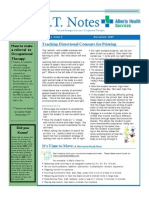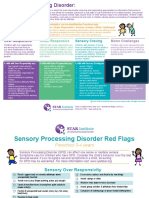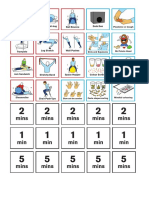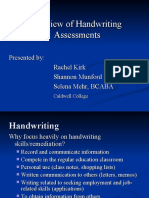Hand Dominance - Under 5's: The Following Is A List of Games and Activities To Help Develop Hand Dominance
Hand Dominance - Under 5's: The Following Is A List of Games and Activities To Help Develop Hand Dominance
Uploaded by
Damayanti ThapaCopyright:
Available Formats
Hand Dominance - Under 5's: The Following Is A List of Games and Activities To Help Develop Hand Dominance
Hand Dominance - Under 5's: The Following Is A List of Games and Activities To Help Develop Hand Dominance
Uploaded by
Damayanti ThapaOriginal Title
Copyright
Available Formats
Share this document
Did you find this document useful?
Is this content inappropriate?
Copyright:
Available Formats
Hand Dominance - Under 5's: The Following Is A List of Games and Activities To Help Develop Hand Dominance
Hand Dominance - Under 5's: The Following Is A List of Games and Activities To Help Develop Hand Dominance
Uploaded by
Damayanti ThapaCopyright:
Available Formats
Children’s Community Occupational Therapy
Hand Dominance – Under 5’s
What is it? Hand dominance is the preference of one hand to perform fine and gross motor tasks, such as
writing, cutting or catching and throwing a ball. When one hand is consistently used more than the other hand,
and is more skilled at tasks than the other hand. This is also referred to as hand preference. Children typically
develop hand dominance between the age of 2 and 4 years.
The dominant hand and the non-dominant hand plays a significant role in completing tasks. Both hands working
together is known as bilateral coordination and is important in many school-related tasks.
Why is it important? : Some people are good at using both hands (ambidextrous) but it is much better for a child
to develop strength and dexterity in one hand. This will help them to develop accuracy and speed with fine motor
tasks, particularly handwriting. It is far better to have a specialised hand to do the job well than two less
developed hands.
How you can help:
Offer your child plenty of every day opportunities to participate in developing their hand skills. When
working on establishing dominance, encourage daily activities that require continued use of one hand
without direction as to which hand to use. Place materials at the child’s midline (directly in front of the
middle of their trunk), and allow the child to choose and switch hand freely during these activities and
other activities;
Ensure your child is sitting with a comfortable and supported posture (e.g. feet on the floor, and elbows
resting on the table at a 90 degree angle) or is standing up at a vertical surface.
Minimise emphasis on dominant and non-dominant hand and allow child to freely alternate hand use.
After several weeks of daily undirected hand activity, watch for one hand to be chosen more frequently for
one handed activities or used more consistently for grasping for writing implements, scissors etc.
When you note preference for one hand emerges, focus on developing the dominant and assisting roles
for the two hands.
The following is a list of games and activities to help develop hand dominance:
Large scribbling on the chalkboard or drawing on mural paper that is on a easel or taped to the wall or
floor
Hammering wood that is clamped to a surface
Pounding a large ball or clay with one hand until it is flat
Swinging a ball on a string above head
Throwing small balls or beanbags with one hand.
Examples or activities include when dominant hand is chosen:
Drawing, writing, or painting with one hand, stabilising paper with the other.
Cutting with one hand, stabilising and turning paper with the other.
Using one hand to build towers with blocks, stabilising and helping to keep blocks lined up with the other.
Tracing or scribbling over templates, holding writing implement with one hand while stabilising paper with
the other.
Opening containers, such as jars or plastic containers with lids that require stabilisation with one hand and
action with other.
You might also like
- Primitive ReflexesDocument85 pagesPrimitive ReflexesBernadette hauw92% (13)
- The Handwriting Book FinalDocument57 pagesThe Handwriting Book Finaljessica-clare.davisNo ratings yet
- Gvhs PSL Cda PortfolioDocument71 pagesGvhs PSL Cda Portfolioapi-45745329867% (6)
- Exercises of Practical Life: AREA 1 - Elementary Movements and Preliminary ActivitiesDocument19 pagesExercises of Practical Life: AREA 1 - Elementary Movements and Preliminary Activitieslotta100% (2)
- Kids Cut Packet PDFDocument50 pagesKids Cut Packet PDFPaloma McNo ratings yet
- Sensory Environment AssessmentDocument2 pagesSensory Environment AssessmentDamayanti Thapa100% (1)
- Movement ABC 2 Frequently Asked QuestionsDocument8 pagesMovement ABC 2 Frequently Asked QuestionsCat Graverobber Iskariot0% (1)
- Kids Cut PacketDocument50 pagesKids Cut Packetapi-260541427100% (4)
- Knapp and Turnbull ABA Curriculum PDFDocument426 pagesKnapp and Turnbull ABA Curriculum PDFBraile A100% (4)
- Writing OT Fine Motor Development Guide For Teachers1Document30 pagesWriting OT Fine Motor Development Guide For Teachers1maria vasquez100% (3)
- A Fine Motor and Handwriting Resource Guide: By: Elisa Pomeranz, MS, OTR/LDocument17 pagesA Fine Motor and Handwriting Resource Guide: By: Elisa Pomeranz, MS, OTR/Lmaria vasquezNo ratings yet
- Hand DominanceDocument2 pagesHand DominanceLuca MihailNo ratings yet
- Developing Coordinated Hand Use Hand DominanceDocument2 pagesDeveloping Coordinated Hand Use Hand DominanceDamayanti ThapaNo ratings yet
- Early Years Hand SkillsDocument7 pagesEarly Years Hand SkillsFatima Louise VillarandaNo ratings yet
- Fine Motor Activities For PreschoolersDocument4 pagesFine Motor Activities For Preschoolerspriyaspv100% (1)
- Pre Writing SkillsDocument4 pagesPre Writing Skillsfreesia alshomraniNo ratings yet
- Dasar TeoriDocument3 pagesDasar Teorihr.cginteriorNo ratings yet
- Principles of Handwriting Development: Children's Occupational TherapyDocument9 pagesPrinciples of Handwriting Development: Children's Occupational TherapyDalan DanNo ratings yet
- Ot Pre-Referral Form: Intervention Strategies: Poor Posture/ Falls Out of Chair/ Slumps Significantly (All Ages)Document15 pagesOt Pre-Referral Form: Intervention Strategies: Poor Posture/ Falls Out of Chair/ Slumps Significantly (All Ages)maria vasquezNo ratings yet
- Introduction To Fine Motor DevelopmentDocument14 pagesIntroduction To Fine Motor Developmentlicurici_love_pacifiNo ratings yet
- Helping Hands-Website InformationDocument17 pagesHelping Hands-Website InformationDiana Moore Díaz100% (1)
- Using A PencilDocument7 pagesUsing A Pencilmaria vasquez100% (1)
- Tips From An OT - Developing Your Child's Pencil Grip - Source KidsDocument13 pagesTips From An OT - Developing Your Child's Pencil Grip - Source KidsAleh LucianoNo ratings yet
- Highchair PlayDocument2 pagesHighchair PlayMeggie PhamNo ratings yet
- Fine Motor SkillsDocument5 pagesFine Motor SkillsguisdanrujhieneNo ratings yet
- Crossing-Midline-Bilateral-Skills-for-schoolsDocument2 pagesCrossing-Midline-Bilateral-Skills-for-schoolsvanessahenrichNo ratings yet
- Tools to Grow at Home - Bilateral Hand UseDocument1 pageTools to Grow at Home - Bilateral Hand UsevanessahenrichNo ratings yet
- Fine Motor Skill Development 0-6 YearsDocument2 pagesFine Motor Skill Development 0-6 YearsRio Agus EfendiNo ratings yet
- Pencil Grasp ActivitiesDocument1 pagePencil Grasp ActivitiesBudihoi cameliaNo ratings yet
- Fine Motor Activities For HomeDocument6 pagesFine Motor Activities For HomeNoor Farhana NanaNo ratings yet
- Skills For Developing A Pencil GraspDocument4 pagesSkills For Developing A Pencil GraspSiew Hiong JongNo ratings yet
- Microsoft Word - First SchoolDocument78 pagesMicrosoft Word - First SchoolMeana AnanNo ratings yet
- Fine Motor DevelopmentDocument3 pagesFine Motor Developmentjassen karylle IbanezNo ratings yet
- 1 Tips To Improve HandwritingDocument1 page1 Tips To Improve HandwritingCarlo PreciosoNo ratings yet
- 1: Foundation Skills: Baseline and Outcome AssessmentDocument2 pages1: Foundation Skills: Baseline and Outcome AssessmentpratibhaumrariyaNo ratings yet
- Manipulative skillsDocument28 pagesManipulative skillsmahmoudamer1292002No ratings yet
- MPDFDocument7 pagesMPDFFANUTA PARTALNo ratings yet
- Printing PDFDocument1 pagePrinting PDFapi-81941124No ratings yet
- Pencil Grip ActitiesDocument5 pagesPencil Grip Actitiesmatkai100% (1)
- Occupational Therapy - Kids Health Information: Hand PreferenceDocument6 pagesOccupational Therapy - Kids Health Information: Hand PreferenceDamayanti ThapaNo ratings yet
- Children'S DevelopmentDocument7 pagesChildren'S DevelopmentWahidah NisaNo ratings yet
- Handwriting - CaligrafiaDocument61 pagesHandwriting - CaligrafiaJoana SantosNo ratings yet
- Hand Exercise Ideas.201520504Document8 pagesHand Exercise Ideas.201520504Radoslava NedyalkovaNo ratings yet
- Writing Readiness - ReferenceDocument5 pagesWriting Readiness - Referencemargie fulgencioNo ratings yet
- I Am Thankful For My Hands: LessonDocument5 pagesI Am Thankful For My Hands: LessonPKMNo ratings yet
- HandsLevity Renwal2013Document5 pagesHandsLevity Renwal2013Ken KenNo ratings yet
- Chapter III PEHDocument20 pagesChapter III PEHmalorenceaNo ratings yet
- Disease Prevention - Hand MappingDocument15 pagesDisease Prevention - Hand Mappingapi-357140234No ratings yet
- Mark Making and Early WritingDocument8 pagesMark Making and Early WritingyayadocmoNo ratings yet
- Pre Writing SkillsDocument14 pagesPre Writing SkillsAeindrayNo ratings yet
- Handwriting PackDocument40 pagesHandwriting Packa3882100% (2)
- Play Engagement Guidebook - FINALDocument26 pagesPlay Engagement Guidebook - FINALLiliane ResendeNo ratings yet
- GROW - Bulletin - Learner AssessmentDocument9 pagesGROW - Bulletin - Learner Assessmentrethabilesikhosana6No ratings yet
- Oum 1 BDocument10 pagesOum 1 BLaswan SontengNo ratings yet
- Developing Writing Skills: Wendy GoldupDocument23 pagesDeveloping Writing Skills: Wendy GoldupBayissa BekeleNo ratings yet
- Occupational Therapy Home Activities 2020Document34 pagesOccupational Therapy Home Activities 2020pratibhaumrariyaNo ratings yet
- 7.0 and 7.1 Principles of Normal Development in Infancy and Early Childhood 2Document26 pages7.0 and 7.1 Principles of Normal Development in Infancy and Early Childhood 2만새No ratings yet
- Fine Motor Skill Development PDFDocument3 pagesFine Motor Skill Development PDFElisa GuraNo ratings yet
- A Guide To Bilateral Coordination VllmomDocument18 pagesA Guide To Bilateral Coordination VllmomMehali Patel100% (1)
- CARESOSA - Research Questions Set 2Document5 pagesCARESOSA - Research Questions Set 2Lucille CaresosaNo ratings yet
- Stages of Development: InfancyDocument52 pagesStages of Development: InfancylottaNo ratings yet
- How To Promote Self-Determination For Children With DisabilitiesDocument5 pagesHow To Promote Self-Determination For Children With DisabilitiesSandra Gabriela L. OliveiraNo ratings yet
- Growth and DevelopmentDocument4 pagesGrowth and DevelopmentKirsten Moreen GuevarraNo ratings yet
- The Hand Strengthening HandbookDocument49 pagesThe Hand Strengthening HandbookdrislettieriNo ratings yet
- Ece 302 Lesson 4 Curriculum and The Developing Child (Developmental Domain)Document47 pagesEce 302 Lesson 4 Curriculum and The Developing Child (Developmental Domain)Charisse May Dela RosaNo ratings yet
- Baby Milestones- How to Navigate the World of Developmental MilestonesFrom EverandBaby Milestones- How to Navigate the World of Developmental MilestonesNo ratings yet
- Organized and Engaged: Simple and Effective Strategies to Support Executive FunctionFrom EverandOrganized and Engaged: Simple and Effective Strategies to Support Executive FunctionNo ratings yet
- Early Childhood Measurement ToolDocument4 pagesEarly Childhood Measurement ToolDamayanti ThapaNo ratings yet
- Gross Motor Skills: Children, Young People and Families Occupational Therapy TeamDocument12 pagesGross Motor Skills: Children, Young People and Families Occupational Therapy TeamDamayanti Thapa100% (2)
- OT HOME PACKET - ComprehensiveDocument5 pagesOT HOME PACKET - ComprehensiveDamayanti ThapaNo ratings yet
- Activities To Improve Fine M Otor, Visual Motor & Visual Perceptual Skills at HomeDocument1 pageActivities To Improve Fine M Otor, Visual Motor & Visual Perceptual Skills at HomeDamayanti ThapaNo ratings yet
- Visual Motor Integration: Go To For The Complete DownloadDocument1 pageVisual Motor Integration: Go To For The Complete DownloadDamayanti ThapaNo ratings yet
- Sensory Integration Therapy Auditory Integration Training Ohp PDFDocument10 pagesSensory Integration Therapy Auditory Integration Training Ohp PDFDamayanti ThapaNo ratings yet
- Tips For Sensory-ProcessingDocument6 pagesTips For Sensory-ProcessingDamayanti Thapa100% (1)
- Proprioceptive Activities: 301 Dogwood Street, Campbell River, B.C. V9W 2Y1Document1 pageProprioceptive Activities: 301 Dogwood Street, Campbell River, B.C. V9W 2Y1Damayanti ThapaNo ratings yet
- Sensory Symptoms ChecklistDocument3 pagesSensory Symptoms ChecklistDamayanti ThapaNo ratings yet
- The Money and Abundance PrayerDocument1 pageThe Money and Abundance PrayerNorthCarolinaNo ratings yet
- Occupational Therapy - Kids Health Information: Hand PreferenceDocument6 pagesOccupational Therapy - Kids Health Information: Hand PreferenceDamayanti ThapaNo ratings yet
- Preschool Sensory Resource - 0Document3 pagesPreschool Sensory Resource - 0Damayanti ThapaNo ratings yet
- Determining A Student's Hand Dominance For Teachers: Materials NeededDocument1 pageDetermining A Student's Hand Dominance For Teachers: Materials NeededDamayanti ThapaNo ratings yet
- Example: When I Come To The Chill Out Room I Will Do ThisDocument1 pageExample: When I Come To The Chill Out Room I Will Do ThisDamayanti ThapaNo ratings yet
- Mins Mins Mins Mins Mins: Dumbell Press Stability-Ball-Hug Ball Bounce Dark DenDocument1 pageMins Mins Mins Mins Mins: Dumbell Press Stability-Ball-Hug Ball Bounce Dark DenDamayanti ThapaNo ratings yet
- 9 I Need To LeaveDocument1 page9 I Need To LeaveDamayanti ThapaNo ratings yet
- Checklist For Pencil CaseDocument2 pagesChecklist For Pencil CaseDamayanti ThapaNo ratings yet
- ED 572 Handwriting AssessmentsDocument50 pagesED 572 Handwriting AssessmentsElla_Jane_Uych_6536No ratings yet
- The Maintenance HandbookDocument136 pagesThe Maintenance HandbookAxelrose04No ratings yet
- Stages of DevelopmentDocument5 pagesStages of Developmentndah rosanahNo ratings yet
- Exner 10Document8 pagesExner 10Sara CarvalhoNo ratings yet
- DonVito's Ultimate GuideDocument37 pagesDonVito's Ultimate GuideDonnVito75% (4)
- (FREE PDF Sample) NCFE CACHE Level 1 2 Technical Award in Child Development and Care in The Early Years Second Edition Burnham EbooksDocument84 pages(FREE PDF Sample) NCFE CACHE Level 1 2 Technical Award in Child Development and Care in The Early Years Second Edition Burnham Ebookspuomiosenni100% (6)
- Coordination Abilities in Volleyball Coordination Abilities in VolleyballDocument88 pagesCoordination Abilities in Volleyball Coordination Abilities in VolleyballKlgo. Fernando HuertaNo ratings yet
- Fantasy Age - Abdanck's Homebrew RulesDocument17 pagesFantasy Age - Abdanck's Homebrew RulesAbdanck100% (11)
- Report Pedia (Infant)Document3 pagesReport Pedia (Infant)marilexdomagsangNo ratings yet
- RPT SJKC English KSSR Year 1Document14 pagesRPT SJKC English KSSR Year 1Audrey YeeNo ratings yet
- Adaptive Apparel Design 1698677084Document73 pagesAdaptive Apparel Design 1698677084ukhan123No ratings yet
- Fleishmans Taxonomy of Human Abilities 2017Document6 pagesFleishmans Taxonomy of Human Abilities 2017samayoamichael01No ratings yet
- MRMTDocument5 pagesMRMTKirtiNo ratings yet
- Chap 5 Employee Testing and Selection and InterviewingDocument47 pagesChap 5 Employee Testing and Selection and InterviewingshekharrevatiNo ratings yet
- ActivityDocument4 pagesActivityCatherineNo ratings yet
- The Effect of Temperature On Manual Dexterity, Reaction Time, and Optimum Grip-SpanDocument5 pagesThe Effect of Temperature On Manual Dexterity, Reaction Time, and Optimum Grip-SpanMladen PuljićNo ratings yet
- Physical Growth ChildhoodDocument6 pagesPhysical Growth ChildhoodPuneet RepalleNo ratings yet
- Early ChildhoodDocument58 pagesEarly ChildhoodMayang SokistaNo ratings yet
- HighScope Preschool Curriculum Preview KitهايسكوبDocument59 pagesHighScope Preschool Curriculum Preview KitهايسكوبKliopatra Egy67% (3)
- Fine Motor Activities For HomeDocument6 pagesFine Motor Activities For HomeNoor Farhana NanaNo ratings yet
- Physical Development of Infants and ToddlersDocument39 pagesPhysical Development of Infants and ToddlersMylene Mahinay80% (5)
- My Summer Workbook K1 2022Document74 pagesMy Summer Workbook K1 2022Elaine Sherry Arboli100% (1)
- Quickstart ENGDocument35 pagesQuickstart ENGSztankovits BotondNo ratings yet









































































































